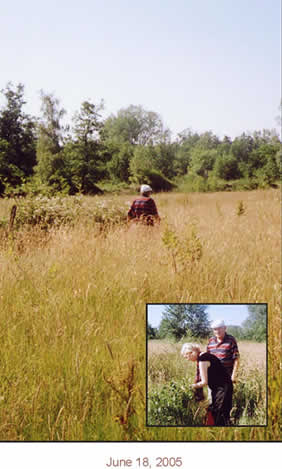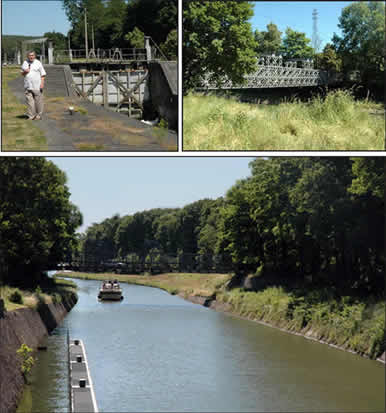- Home
- Knox Family
- Knox Family Relatives
- ME 846 History
- E-Books
- Newsletters
- Contact
Searching for Captain Davis Part I
Peter Knox in Belgium — June — September 1944 June 21 1944 was a very busy night over the skies of Belgium. It was the shortest night of the year and many lives were to change. This was true of the many casualties that night but it was also true for the crew of Lancaster ME846 when at 01.20 BST it was hit by ground fire. Peter Knox wrote, "The starboard engine was on fire and Captain Davis said in a calm, clipped voice "abandon aircraft-----emergency jump jump."We each had to confirm over the inter-com that we were jumping. As I had to lift up the escape hatch I responded first "air-bomber jumping”. There was no shouting, no calls for help. In a numbed state, I moved into the escape routine…all this time the pilot was holding the plane steady." Captain Davis must have known his fate, in the face of death he made the greatest of all sacrifices; he kept the plane steady so that his crew could bail out. It is certainly one thing to be trained to do this but it takes the greatest act of heroism to make a life and death decision so that others can be saved. Captain Davis must never be forgotten by those who owe him their existence. For Sgt. Peter Knox, RAAF, it was also going to become one of the most defining moments of his life because in facing the pulsating reality of death powerful forces are at work. As Peter Knox was to write fifty years later of his experience immediately on leaving the aircraft. |
 |
|
|
"This was an environment for which there had been no rehearsal. I was no longer responding like a robot to in-built commands. The disaster which had hit us struck me…then I recollect thanking God I had escaped and rather desperately willing that my mother and father should somehow know I was alive. Within a very short space of time I saw the explosion as our plane plummeted into the ground. I wondered if the others had got out and I shouted out the name of "George"(Moggridge). My voice seemed to be lost in the vast dark space around me and I realised there was no possibility of making any form of human contact.”…it took some 15 minutes to reach the ground…I passed through some clouds and hit the ground on the fringe of a pine forest. My parachute was snagged on a small tree. Luck was on my side. I was unhurt. The weather was fine. It was dark and I was in an isolated area.” From this moment on Peter Knox followed the instructions given in those hours of drill. He got out his emergency pack, compass, knife, iron rations and water purification tables. He then hid his parachute and any identifying clothing in a small hollow and piled pine needles on top. As instructed, he headed west following a track, there were houses nearby. He wrote: "After an hour or two I came to a canal. There was a lock and barges tied up to the bank. Since this was the shortest night of the year, it was getting close to dawn and I was tired. I found a deep hol low on a hillock overlooking the lock and decided to make that my hiding place for the day…only one person saw me a young schoolboy out for a ramble. He gave me a friendly smile and fled. He obviously did not report me because no one else came remotely close…there was no telling the most likely spot to fall into friendly hands…I knew that I only had rations for two or three days..I stuck to my plan of walking west..crossing the canal became a challenge and, besides, I needed water..as dusk settled I summed up courage and walked to the lock...I watched until the keeper was well away from the little foot bridge on the rim of the lock and moved quickly across it...once clear of the lock I scrambled down the bank. |
||
| When it was completely dark, I set off along a track which looked reasonably deserted and kept walking away from the canal. All was quiet and I was able -to skirt any houses that I saw. At the first light of dawn I came to a main road with fields on the other side. As I crossed it a group of cyclists came into sight. They looked like workers heading for a factory. When they passed me, one of them wheeled his bicycle around, stared and then re-joined the others. I just put my head down and kept walking. I realised that I had to find a hiding place for the day now that people were up and about. The lane I was in forked left and right and I remember thinking that this could be a decisive choice. I went left and after a few minutes saw a hedgerow bisecting a field. Because it was midsummer the hedgerow was in full leaf. I found a place with a little hollow, well hidden from view. I still had some of my rations left and do not recollect feeling hungry. It was still dry and warm. The shoes made from the cut down flying boots were fleece lined and my feet were sweating. I took my shoes off and hung up my socks on an inside branch to give them some air. I felt reasonably secure for the day and snatched some sleep. At some time in the middle of the day I heard a dog barking and within a few minutes it had unearthed me. A man, presumably the farmer, pushed aside |
 |
|
| the leaves. (See Alfonse Vermierdt below) He was clearly not a German and I knew that the moment had come to identify myself. I said in French that I was "aviateur anglais"and he and the dog very quickly disappeared. There was nothing I could do except wait, hope and pray that he was a Dutch or Belgian patriot . I still did not know on which side of the border I had landed. Alfonse Vermierdt – the boy with the dog who found Peter Knox in this field behind their home in Reysberg (June 1944). With Jane Knox-Kiepura (inset). It was close to evening when I heard voices and two men approached me. (KM: This most likely to be the Cools brothers, who were members of the Balen-Resistance. They went to the Vermierdt family home in Reysberg to look after PEK-who then moved him to a stable in the meadows on the other side of the village - Schoorheide-Malou, where he stayed for 24 hours). I again used my schoolboy French to explain who I was. This was a tense moment for them as well as for me. If they were going to hand me over to the Germans I would lose my freedom. If I was a German posing as an English airman to infiltrate the underground movement they stood to lose their lives. They said they were friends and told me to follow them at a distance of 50 yards or so. There was no other conversation. I obeyed their instructions and we wandered through more lanes to a farm. They pointed to a barn with a hay loft and told me to wait there. I went up a ladder and lay down in the hay. Before long another man came back with some food. He spoke some English and now the interrogation began. We were both nervous. In the event of being captured, our instructions were to tell the German interrogators nothing except our "name, rank and number."On the other hand we had been told that if we were lucky enough to be picked up by the Resistance movement they would have to establish our credentials and ask very direct questions to verify we were genuinely from an RAF plane. They would also want this type of information so that they could compare it to replies received from any other members of the crew they might pick up. This would help them confirm they were dealing with genuine airmen. I was asked for the number of the squadron, the airport from which we had left, the name of the pilot, the target, the type of plane and its engines, when and how we had been shot down. I was plied with questions about England and asked to name the latest popular songs. I accepted that I truly was in the hands of the underground movement and provided answers to all the questions. I was grateful for one thing, the interrogator did not ask to see my "dog tags”, the metal discs we wore around our necks with such basic information as name and blood group. I had taken a shower before getting into my flying gear and had left these identification markers back in a squadron bathroom. I slept well that night in the hay. The human contact had been reassuring and I felt that there was nothing I could do except to follow the instructions I received from the people who had found me. They brought me more food in the morning—both meals were of omelettes and fried potatoes as I recall and some form of warm drink. They tasted good. I think that I must have relaxed after the tension of the previous three days because I have only a hazy memory of my movements in the next day or two. I saw only the person bringing me food and rested and slept. I imagine, in retrospect, that someone was vetting my answers and planning what to do with me. I was moved away from the farm and taken to the middle of a small pine forest to be held in isolation for two or three more days. My minder was a youngish man who spoke some English. This was Col. Victor Neels - see separate page. I knew now that I was in the Flemish speaking part of Belgium close to the border with Holland but little else. I was given a blanket and a waterproof sheet and food was brought to me a couple of times a day. I used the waterproof sheeting to make a type of tent under some branches and must have spent most of the time keeping out of sight. Not that I recall seeing any strangers. I do remember that there was a tremendous thunderstorm. The rain took a long time to penetrate the pines. I thought that I was lucky until I found that the water kept dripping off the lower branches for hours after the storm had passed on its way. (KM - Victor Neels had taken Peter Knox to Iemert - to the home of Neel's aunt Mrs. Josephine Gombeer who married Leo Timmermans where Knox was hidden in the woods, in a place where there were also escaped Russian POW's. Four days later Neels took Peter Knox to Mrs. Jeanne Leemans-Schlesser in Geel.) Within a week of being shot down I was accepted as a valid RAF escaper and on 26 June 1944. I was brought into direct contact with the Resistance movement. |
||
Contact Us | Site Map